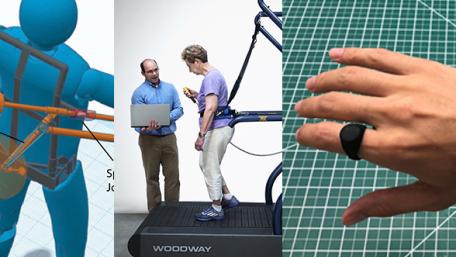Body
Robot-assisted therapy has shown significant promise for enhancing physical outcomes for individuals with a neurological disability, such as stroke or spinal cord injury. Much of this research has focused on robotic devices that physically guide patients in a repetitive motion with the therapist acting as a bystander. While this approach has been useful in providing patients with access to more movement training, therapeutic gains are still variable and clinical acceptance may be slow.
With three cycles of funding from The National Institute on Disability, Independent Living, and Rehabilitation Research (NIDILRR), the Machines Assisting Recovery from Stroke and Spinal Cord Injury (MARS) center cultivated a variety of novel software and hardware innovations that facilitated this robotic therapy approach but also revealed limits, leading to exploration of alternative approaches, including use of passive mechanical devices, sensor-based approaches, movement augmentation strategies, body-machine interfaces, and challenge-based strategies.
Leveraging this knowledge, expertise, and preliminary work, we have established a new center — Collaborative Machines Enhancing Therapies (COMET) — coalesced around scientific enthusiasm for an alternative strategy of machine-assisted movement therapy. We seek to design technologies that involve both therapists and clients in implementing unique and effective therapeutic strategies that target specific impairments and rehabilitation problems in ways that would otherwise be impossible.
COMET brings together research and development projects targeted at two grand challenges: improving gait and manipulation (the ability to use everyday objects) outcomes. We will also evaluate the collaborative machines we develop in a first-of-its-kind observational study at the Shirley Ryan AbilityLab that will identify the factors that predict the uptake of such devices.
We expect that this research will benefit persons with stroke and spinal cord injury, as well as other neurological conditions, including cerebral palsy (CP), multiple sclerosis (MS), and Parkinson’s disease.
Projects
Body
Smart Passive Devices for Recovery of Arm Function: Simple, passive wearable devices that can function as collaborative machines.
Wearable Sensor for Encouraging Movement Practice: A non-obtrusive wearable sensor that can collaborate with the patient and therapist to accurately measure important target movements.
Soft Exoskeleton for Functional Gait Recovery in Stroke: An exoskeleton that conforms to the body and aids in gait training after stroke.
Robotic Treadmill for Intense, Adaptive Propulsion Training: A clinically-viable machine focused on re-training the paretic (partially paralyzed) limb after stroke.
Targeted Brain and Muscle Feedback for Hand Recovery: A novel collaborative technology that combines two feedback methods to promote movement therapy.
An Adaptive Wearable Balance Trainer: A wearable device that enables innovative types of training that can be integrated into clinical practice.
A Body-Machine Interface for Recovery of Muscle Control: New generation BMIs that integrate muscle activities and motion signals for operating external devices and performing rehabilitation exercises.
Body
The contents of this webpage were developed under a grant from the National Institute on Disability, Independent Living, and Rehabilitation Research (NIDILRR grant number 90REGE0005-01-00). NIDILRR is a Center within the Administration for Community Living (ACL), Department of Health and Human Services (HHS). The contents of this webpage do not necessarily represent the policy of NIDILRR, ACL, or HHS, and you should not assume endorsement by the Federal Government.
_____________________________
Recent Publications:

